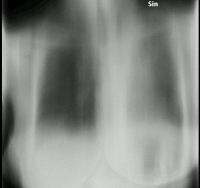
Photo from wikipedia
Purpose To evaluate the image quality and lesion visibility of virtual monoenergetic images (VMIs) reconstructed using a new monoenergetic reconstruction algorithm (nMERA) for evaluation of breast cancer. Materials and methods… Click to show full abstract
Purpose To evaluate the image quality and lesion visibility of virtual monoenergetic images (VMIs) reconstructed using a new monoenergetic reconstruction algorithm (nMERA) for evaluation of breast cancer. Materials and methods Forty-two patients with 46 breast cancers who underwent 4-phasic breast contrast-enhanced computed tomography (CT) using dual-energy CT (DECT) were enrolled. We selected the peak enhancement phase of the lesion in each patient. The selected phase images were generated by 120-kVp-equivalent linear blended (M120) and monoenergetic reconstructions from 40 to 80 keV using the standard reconstruction algorithm (sMERA: 40, 50, 60, 70, 80) and nMERA (40 +, 50 +, 60 +, 70 +, 80 +). The contrast-to-noise ratio (CNR) was calculated and objectively analyzed. Two independent readers subjectively scored tumor visibility and image quality each on a 5-point scale. Results The CNR at 40 + and tumor visibility scores at 40 + and 50 + were significantly higher than those on M120. The CNR at 50 + was not significantly different from that on M120. However, the overall image quality score at 40 + was significantly lower than that at 50 + and on M120 (40 + vs M120, P < 0.0001 and 40 + vs 50 +, P = 0.0001). Conclusions VMI reconstructed with nMERA at 50 keV is preferable for evaluation of patients with breast cancer.
Journal Title: Japanese Journal of Radiology
Year Published: 2019
Link to full text (if available)
Share on Social Media: Sign Up to like & get
recommendations!